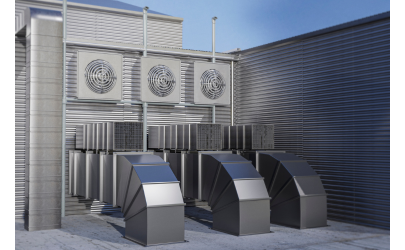AI-Driven Efficiency: The Rise of Adaptive Adiabatic Coolers in High-Humidity Asia-Pacific Regions

"In the Asia-Pacific region, a notable trend in the adiabatic coolers market is the incorporation of dynamic, climate-adaptive control systems tailored for high-humidity and variable-temperature environments. These modern systems feature AI-enhanced controllers, EC (electronically commutated) fans, and modulating spray mechanisms, which activate pre-cooling solely when ambient dry-bulb conditions are thermodynamically advantageous. This approach maximizes energy efficiency while minimizing water usage. Such intelligent mechanisms are especially critical in tropical regions like Southeast Asia, where standalone adiabatic systems often face challenges due to high humidity levels. Hybrid configurations that alternate between evaporative and mechanical cooling help maintain performance, achieving reductions in capital expenditure of 20–25% and ensuring year-round reliability.
Major markets in APAC, including China, India, and Australia, are also integrating these systems with renewable energy sources, particularly solar power, to improve sustainability and resilience during heat waves. This alignment with regional water-conservation mandates and energy regulations underscores a significant evolution in the HVAC landscape within the region, characterized by the convergence of smart cooling solutions, water efficiency, and renewable energy."
The Asia Pacific Adiabatic Coolers market was valued at USD 175.62 Million in 2024 and is projected to reach USD 262.19 Million by 2030, with a compound annual growth rate (CAGR) of 19.11% from 2025 to 2030.
The diverse climate in this region also heightens the demand for effective cooling technologies that are more water- and energy-efficient, making adiabatic coolers a smart choice. Moreover, governments across Asia Pacific are increasingly supporting initiatives for green building and energy-saving practices, which is further driving the need for eco-friendly cooling systems.
The market for adiabatic coolers is poised for expansion due to the continuous investments in infrastructure and building, as well as the growing focus on environmental concerns and sustainability. In the upcoming years, this tendency is probably going to continue as companies try to reduce expenses and adhere to rules.
The necessity for effective cooling systems in industries like manufacturing and construction is fuelled by Asia Pacific's expanding industrial and urban development.
As the Asia Pacific region rapidly industrializes and urbanizes, the demand for cooling systems is increasing across various sectors. Countries like China and India are experiencing significant industrial growth, marked by the rise of manufacturing plants, commercial buildings, and residential complexes. In urban areas, the construction of high-rise buildings, shopping malls, and office spaces is on the rise, all of which require efficient HVAC systems. Adiabatic coolers offer a sustainable and cost-effective solution that is suitable for both industrial and commercial applications. The increasing number of industries and urban developments is expected to further drive the demand for these energy-efficient cooling systems.
Rising energy costs and environmental concerns drive the demand for energy-efficient cooling technologies, such as adiabatic coolers.
Energy consumption and rising electricity costs are significant concerns for industries and businesses throughout the Asia Pacific region. As governments and organizations strive to reduce energy usage to combat climate change, energy-efficient solutions like adiabatic coolers are becoming increasingly appealing. Unlike traditional cooling methods that consume large amounts of electricity, adiabatic coolers utilize natural evaporation to lower temperatures, resulting in decreased energy consumption. This emphasis on sustainability and energy savings aligns with both cost reduction goals and the need to comply with regulatory standards, making adiabatic coolers a highly preferred option.
Adiabatic coolers use less water than traditional cooling methods, making them an appealing option in regions facing water shortages.
Many parts of Asia Pacific, such as India and China, are facing water scarcity, making it crucial to reduce water consumption in industrial and commercial cooling processes. Traditional cooling systems, particularly evaporative cooling towers, use vast amounts of water, which can strain local water resources. In contrast, adiabatic coolers consume significantly less water by leveraging the natural cooling effect of evaporation without requiring large amounts of water for operation. This makes them a more sustainable option in water-scarce regions, where reducing water usage is essential to address growing environmental concerns.
Strict environmental regulations and green building standards encourage the adoption of eco-friendly and energy-efficient cooling solutions in the region.
Governments in the Asia-Pacific region are increasingly implementing strict environmental regulations and promoting sustainable practices. Policies and building codes are encouraging businesses to adopt greener technologies that minimize environmental impact, particularly regarding energy consumption and water use. Adiabatic coolers present an ideal solution, as they meet these regulations by providing a highly energy-efficient and eco-friendly cooling alternative. With growing awareness of climate change and sustainability, governments are incentivizing businesses to invest in cooling technologies that reduce carbon footprints, which further boosts the market for adiabatic coolers.
The expansion of IT infrastructure and data centers in Asia Pacific increases the need for reliable and efficient cooling systems to manage heat and maintain equipment performance.
As the Asia Pacific region embraces digital transformation, there’s an increasing need for data centers and robust IT infrastructure. These data centers rely on advanced cooling systems to keep things running smoothly; otherwise, overheating can cause serious system failures. Adiabatic coolers step in as a smart solution, providing excellent temperature control while using less energy than traditional air conditioning units. With the region’s growing dependence on digital services, cloud computing, and big data analytics, the expansion of data centers highlights the need for efficient cooling options like adiabatic coolers.
Competitive Landscape
Some of the major companies operating within the Adiabatic Coolers market are: Thermax, SPX Cooling Technologies, EVAPCO, Alfa Laval, Guntner, Baltimore Aircoil, ICS Cool Energy, FRIGEL and Other.